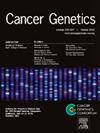The role of miR-10b-5p in prostate cancer and its exosome-mediated angiogenesis effect
IF 2.1
4区 医学
Q4 GENETICS & HEREDITY
引用次数: 0
Abstract
Objective
Prostate cancer (PCa) continues to be a major cause of cancer-related mortality globally, underscoring the critical need for novel therapeutic strategies. This study investigates the oncogenic function of miR-10b-5p in PCa progression and evaluates its potential as both a diagnostic marker and therapeutic target.
Methods
miR-10b-5p was initially identified as a candidate oncogene through bioinformatic analysis of The Cancer Genome Atlas (TCGA) PCa data, followed by validation of its expression levels in clinical PCa specimens via fluorescence in situ hybridization (FISH). Functional assays (proliferation, migration, invasion) were performed to assess the impact of miR-10b-5p on PCa cell behavior. The tumor suppressor ZMYND11 was confirmed as a direct target of miR-10b-5p using dual-luciferase reporter assays. The pro-angiogenic capacity of PCa-derived exosomes harboring miR-10b-5p was evaluated using in vitro endothelial tube formation assays and in vivo mouse models.
Results
miR-10b-5p expression was significantly elevated in PCa tissues and cell lines, and its levels correlated with aggressive tumor features. Mechanistically, miR-10b-5p directly suppressed ZMYND11 expression, thereby promoting PCa cell proliferation, migration, and invasion. Crucially, exosomes derived from miR-10b-5p-expressing PCa cells exhibited potent pro-angiogenic activity, significantly enhancing endothelial tube formation in vitro and stimulating tumor neovascularization in vivo.
Conclusion
This study demonstrates that miR-10b-5p promotes prostate cancer progression by targeting ZMYND11, while its exosomes additionally exhibit pro-angiogenic effects, providing a novel therapeutic target for clinical intervention.
miR-10b-5p在前列腺癌中的作用及其外泌体介导的血管生成作用
前列腺癌(PCa)仍然是全球癌症相关死亡的主要原因,强调了对新型治疗策略的迫切需要。本研究探讨了miR-10b-5p在前列腺癌进展中的致癌功能,并评估了其作为诊断标志物和治疗靶点的潜力。方法通过对癌症基因组图谱(TCGA) PCa数据的生物信息学分析,初步确定smir -10b-5p为候选癌基因,随后通过荧光原位杂交(FISH)验证其在临床PCa标本中的表达水平。通过功能分析(增殖、迁移、侵袭)评估miR-10b-5p对PCa细胞行为的影响。通过双荧光素酶报告基因检测,肿瘤抑制因子ZMYND11被证实是miR-10b-5p的直接靶点。通过体外内皮管形成实验和体内小鼠模型评估含有miR-10b-5p的pca衍生外泌体的促血管生成能力。结果smir -10b-5p在前列腺癌组织和细胞系中表达显著升高,其表达水平与肿瘤侵袭性特征相关。在机制上,miR-10b-5p直接抑制ZMYND11的表达,从而促进PCa细胞的增殖、迁移和侵袭。至关重要的是,来自表达mir -10b-5p的PCa细胞的外泌体表现出强大的促血管生成活性,在体外显著增强内皮管的形成,并在体内刺激肿瘤新生血管。结论本研究表明miR-10b-5p通过靶向ZMYND11促进前列腺癌进展,同时其外泌体还具有促血管生成作用,为临床干预提供了新的治疗靶点。
本文章由计算机程序翻译,如有差异,请以英文原文为准。
求助全文
约1分钟内获得全文
求助全文
来源期刊

Cancer Genetics
ONCOLOGY-GENETICS & HEREDITY
CiteScore
3.20
自引率
5.30%
发文量
167
审稿时长
27 days
期刊介绍:
The aim of Cancer Genetics is to publish high quality scientific papers on the cellular, genetic and molecular aspects of cancer, including cancer predisposition and clinical diagnostic applications. Specific areas of interest include descriptions of new chromosomal, molecular or epigenetic alterations in benign and malignant diseases; novel laboratory approaches for identification and characterization of chromosomal rearrangements or genomic alterations in cancer cells; correlation of genetic changes with pathology and clinical presentation; and the molecular genetics of cancer predisposition. To reach a basic science and clinical multidisciplinary audience, we welcome original full-length articles, reviews, meeting summaries, brief reports, and letters to the editor.
 求助内容:
求助内容: 应助结果提醒方式:
应助结果提醒方式:


